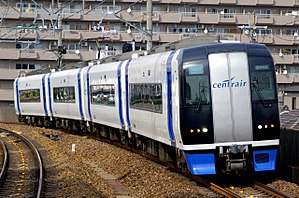Meitetsu 2000 series
The Meitetsu 2000 series (名鉄2000系) is a tilting electric multiple unit (EMU) train type operated by Nagoya Railroad (Meitetsu) on limited express services in Japan since January 2005.[1]
| Meitetsu 2000 series | |
|---|---|
 Meitetsu 2000 series | |
| In service | January 2005 – |
| Manufacturer | Nippon Sharyo |
| Number built | 48 vehicles (12 sets) |
| Number in service | 48 vehicles (12 sets) |
| Formation | 4 cars per trainset |
| Capacity | 181 |
| Operator(s) | Nagoya Railroad |
| Specifications | |
| Car body construction | Steel |
| Doors | 2 per side |
| Maximum speed | 120 km/h (75 mph) |
| Acceleration | 2.3km/h/s |
| Deceleration | 3.5km/h/s 4.2km/h/s (emergency) |
| Electric system(s) | 1,500 V DC |
| Current collection method | Overhead catenary |
| Safety system(s) | ATS |
| Track gauge | 1,067 mm (3 ft 6 in) |
Operations
The 2000 series operates as an access train serving Central Japan International Airport (Centrair), and entered service in January 2005, shortly before the airport opened. The trains made up of 2000 series cars are known as μSky (ミュースカイ, myū sukai), a combination of "μTicket" which is Meitetsu's ticket for first class seats,[2] plus "sky" in reference to the airport. μSky trains can reach Central Japan International Airport Station from Meitetsu-Nagoya Station in 28 minutes with a maximum speed of 120km/h.[3]
While intended for rapid airport service, this train also serves other routes as a regular limited express train.
Formations
The fleet of 12 four-car sets are formed as shown below, with one trailer (T) car and three motored (M) cars.[4] The Mo 2150 cars were added to the original 3-car sets in 2006.
| Car NO. | 1 | 2 | 3 | 4 |
|---|---|---|---|---|
| Designation | Tc | M | M1 | Mc |
| Numbering | 2000 | 2050 | 2150 | 2100 |
Cars 3 and 4 are each equipped with one single-arm pantograph. Car 2 has a toilet.[4]
Each four-car set can carry up to 181 passengers.[3]
The maximum acceleration velocity is 2.3km/h/s and the common deceleration velocity is 3.5km/h/s with an emergency potential of 4.2km/h/s.[3]
Seats and facilities
Seating is arranged 2+2 abreast throughout with a seat pitch of 1,000 mm (39 in).[1] Each car has four luggage spaces (Except a number of sets). Each seat has continuous large windows with UV-cut glass and roll-up curtains that can be operated individually by customers.[3]
- Interior view
History
The trains entered service on 29 January 2005, initially formed as a fleet of 10 three-car sets.[5] From 29 April 2006, additional cars were added to the fleet to form 12 4-car sets to cope with demand.[5]
Awards
In October 2005, the 2000 series was awarded the "Good Design" award.[5]
In June 2006, the train was one of the four recipients of the 46th Laurel Prize presented annually by the Japan Railfan Club.[5][6] A presentation ceremony was held at Central Japan International Airport Station on 4 November 2006.[7]
References
- 私鉄車両年鑑2012 [Japan Private Railways Annual 2012]. Tokyo, Japan: Ikaros Publications Ltd. February 2012. p. 199. ISBN 978-4-86320-549-9.
- "Railway Ticket and First Class Car Ticket (μTicket)". Nagoya Railroad. Retrieved 22 January 2011.
- "名鉄空港特急「ミュースカイ」 - 電車のご利用案内 | 名古屋鉄道". www.meitetsu.co.jp (in Japanese). Retrieved 30 August 2019.
- 私鉄車両編成表 2011 [Private Railway Rolling Stock Formations - 2011]. Japan: JRR. July 2011. p. 100. ISBN 978-4-330-22711-5.
- 名鉄特急の歩み [Meitetsu Limited Express History] (in Japanese). Nagoya Railroad. Retrieved 31 August 2012.
- ブルーリボン賞・ローレル賞 選定車両一覧 [Blue Ribbon Award & Laurel Prize Winner List] (in Japanese). Japan: Japan Railfan Club. 29 May 2012. Archived from the original on 26 October 2010. Retrieved 31 August 2012.
- 2006年鉄道友の会ローレル賞贈呈式開催 [2006 Japan Railfan Club Laurel Prize ceremonies held]. Japan Railfan Magazine (in Japanese). Vol. 47 no. 549. Japan: Koyusha Co., Ltd. January 2007. p. 67.
External links
| Wikimedia Commons has media related to Meitetsu 2000 series. |
- Meitetsu 2000 series information (in Japanese)